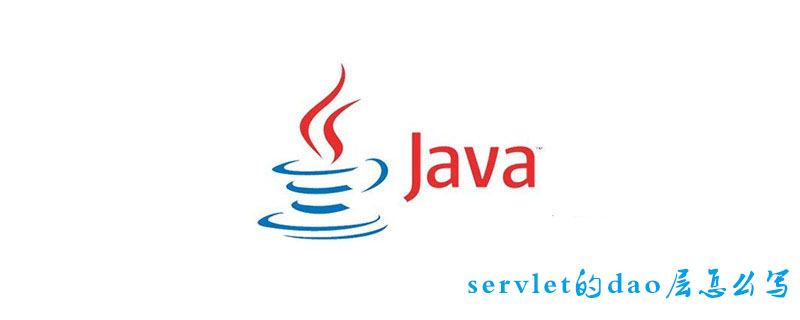서블릿의 DAO 레이어를 작성하는 방법
- (*-*)浩원래의
- 2019-05-16 14:18:117936검색
Dao 레이어: Dao 레이어는 데이터 액세스 레이어라고 하며, 이는 데이터 액세스 개체를 의미하며 특정 테이블이나 엔터티의 추가, 삭제, 수정 및 쿼리를 포함하는 비교적 낮은 수준의 기본 작업입니다.
추천 과정: Java 튜토리얼.

Dao 레이어
먼저 인터페이스 클래스를 선언하고, 클래스에서 사용할 몇 가지 메소드를 선언하고,
이 인터페이스 클래스를 구현하는 동일한 레이어에 클래스를 작성하고, 인터페이스 클래스의 메소드를
다시 작성합니다. 구현 Mybatis 작성 방법
은 주로 데이터를 처리하는 방법입니다.
public interface IStuClassDao {
//全表查询方法
public List findAllStuClassInfo();
//classID查询
public Map<String, Object> findStuClassById(int classId) ;
//增加方法
public void addStuClassById(Stuclass sc) ;
//更新方法
public void updateStuClassById(Stuclass sc) ;
//查询方法
public String findClassNamesByIds(String ids);
}
사용자 작업을 예로 들어 보겠습니다.
Mybatis의 작성 방법은 구현되지 않습니다
AnimalDAO:
package DAO;
import java.sql.Connection;
import java.sql.PreparedStatement;
import java.sql.ResultSet;
import java.sql.SQLException;
import java.util.ArrayList;
import java.util.List;
import util.JDBCUtil;
import entry.Animal;
/**
* 对数据库进行操作
* @author dell-
*
*/
public class AnimalDAO {
//添加动物信息
public void addAnimal(Animal animal){
//1建立连接
Connection conn= JDBCUtil.getConnection();
//2创建sql语句
String sql = "insert into animal (aid,aname,atime)values(?,?,?)";
//3创建sql执行对象
PreparedStatement ps =null;
try {
ps=conn.prepareStatement(sql);
ps.setInt(1, animal.getAid());
ps.setString(2, animal.getAname());
ps.setDate(3, new java.sql.Date(animal.getAtime().getTime()));
ps.executeUpdate();
} catch (SQLException e) {
e.printStackTrace();
}finally{
JDBCUtil.release(null,ps,conn);
}
}
//查询所有信息
public List<Animal> getAll(){
List<Animal> list = new ArrayList<Animal>();
//1连接数据库
Connection conn = JDBCUtil.getConnection();
//2拼装sql
String sql="select * from animal";
//3创建sql执行对象
PreparedStatement ps =null;
ResultSet rs = null;
try {
ps = conn.prepareStatement(sql);
rs=ps.executeQuery();
while(rs.next()){
Animal animal = new Animal();
animal.setAid(rs.getInt("aid"));
animal.setAname(rs.getString("aname"));
animal.setAtime(rs.getDate("atime"));
list.add(animal);
}
} catch (SQLException e) {
e.printStackTrace();
}finally{
JDBCUtil.release(rs, ps, conn);
}
return list;
}
//通过aid 删除动物信息
public void deleteAnimal(int aid){
//1建立数据库连接
Connection conn = JDBCUtil.getConnection();
//2拼装sql
String sql = "delete from animal where aid=?";
//3创建sql执行对象
PreparedStatement ps =null;
try {
ps = conn.prepareStatement(sql);
ps.setInt(1, aid);
ps.executeUpdate();
} catch (SQLException e) {
e.printStackTrace();
}finally{
JDBCUtil.release(null, ps, conn);
}
}
//通过aid修改动物信息
public void updateAnimal(Animal animal){
//1建立连接
Connection conn = JDBCUtil.getConnection();
//2拼装sql
String sql = "update animal set aname=?,atime=? where aid=?";
//3创建sql执行对象
PreparedStatement ps = null;
try {
ps = conn.prepareStatement(sql);
ps.setString(1, animal.getAname());
ps.setDate(2, new java.sql.Date(animal.getAtime().getTime()));
ps.setInt(3, animal.getAid());
ps.executeUpdate();
} catch (SQLException e) {
e.printStackTrace();
}finally{
JDBCUtil.release(null, ps, conn);
}
}
public Animal getAnimalByid(int aid){
//1链接数据库
Connection conn= JDBCUtil.getConnection();
//2创建sql语句
String sql = "select * from animal where aid=?";
//3创建sql执行对象
PreparedStatement ps = null;
ResultSet rs = null;
try {
ps = conn.prepareStatement(sql);
ps.setInt(1, aid);
rs = ps.executeQuery();
if(rs.next()){
Animal animal = new Animal();
animal.setAid(rs.getInt("aid"));
animal.setAname(rs.getString("aname"));
animal.setAtime(rs.getDate("atime"));
return animal;
}
} catch (SQLException e) {
// TODO Auto-generated catch block
e.printStackTrace();
}finally{
JDBCUtil.release(rs, ps, conn);
}
return null;
}
}위 내용은 서블릿의 DAO 레이어를 작성하는 방법의 상세 내용입니다. 자세한 내용은 PHP 중국어 웹사이트의 기타 관련 기사를 참조하세요!
성명:
본 글의 내용은 네티즌들의 자발적인 기여로 작성되었으며, 저작권은 원저작자에게 있습니다. 본 사이트는 이에 상응하는 법적 책임을 지지 않습니다. 표절이나 침해가 의심되는 콘텐츠를 발견한 경우 admin@php.cn으로 문의하세요.
이전 기사:서블릿 인터페이스란?다음 기사:서블릿 인터페이스란?

